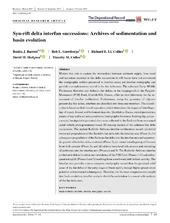| dc.description.abstract | Models that aim to capture the interactions between sediment supply, base level and tectonism recorded in fan delta successions in rift basins have not considered the stratigraphic archive preserved in interfan areas; yet interfan stratigraphy can provide a complementary record to the fan delta axes. The exhumed Early–Middle Pleistocene Kerinitis and Selinous fan deltas, in the hangingwall of the Pyrgaki–Mamoussia (P‐M) Fault, Corinth Rift, Greece, offer an ideal laboratory for the assessment of interfan architecture. Furthermore, using the geometry of adjacent present‐day fan deltas, interfans are classified into three end‐members. The classification is based on their lateral separation, which determines the degree of interfingering of topset, foreset and bottomset deposits. Qualitative (facies, stratal geometries, nature of key surfaces) and quantitative (stratigraphic thickness, bedding dip, palaeocurrents, breakpoint trajectories) data were collected in the field and from unmanned aerial vehicle photogrammetry‐based 3D outcrop models of the exhumed fan delta successions. The ancient Kerinitis–Selinous interfan architectures record: (a) initial westward progradation of the Kerinitis fan delta into the interfan area (Phase 1), (b) subsequent progradation of the Selinous fan delta into the interfan area and asymmetric growth of both fan deltas eastward (Phase 2), (c) stratal interfingering of foresets from both systems (Phase 3), and (d) relative base‐level fall, erosion and reworking of sediments into the interfan area (Phases 4 and 5). The Kerinitis–Selinous interfan evolution is linked to initial net subsidence of the P‐M Fault (Phases 1–3) and subsequent net uplift (Phases 4 and 5) resulting from a northward shift in fault activity. The interfan area provides a more complete stratigraphic record than the proximal axial areas of the fan deltas of the early stages of basin uplift, through higher preservation potential and protracted submergence. Therefore, for the most comprehensive insight into basin evolution, interfan analysis should be undertaken in concert with analysis of the fan delta axes. | en_US |

